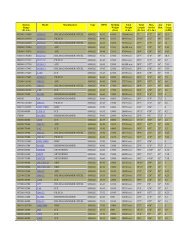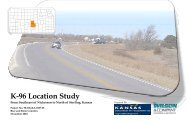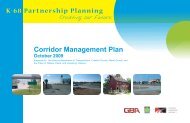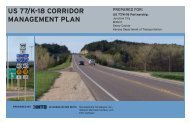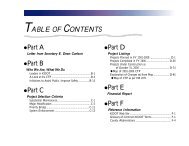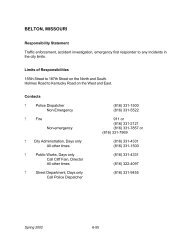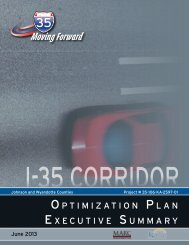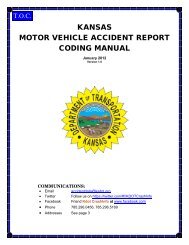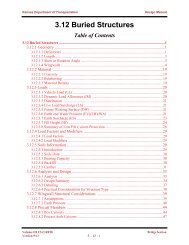Chapter 5 Integration of Transportation Modes and Technologies
Chapter 5 Integration of Transportation Modes and Technologies
Chapter 5 Integration of Transportation Modes and Technologies
Create successful ePaper yourself
Turn your PDF publications into a flip-book with our unique Google optimized e-Paper software.
<strong>Chapter</strong> 5<br />
<strong>Integration</strong> <strong>of</strong> <strong>Transportation</strong><br />
<strong>Modes</strong> <strong>and</strong> <strong>Technologies</strong>
<strong>Integration</strong> <strong>of</strong> <strong>Transportation</strong> <strong>Modes</strong> <strong>and</strong> <strong>Technologies</strong><br />
TEA-21 presents seven factors for states to consider in their long-range<br />
transportation planning. One <strong>of</strong> those factors is to<br />
“enhance the integration <strong>and</strong> connectivity <strong>of</strong> the transportation system, across<br />
<strong>and</strong> between modes throughout the State, for people <strong>and</strong> freight…”<br />
This chapter seeks to address the integration <strong>of</strong> the various modes, <strong>and</strong> also the<br />
technologies supporting <strong>and</strong> enhancing those modes, so that all places <strong>and</strong> facilities in the<br />
state become more accessible to its citizens <strong>and</strong> travelers.<br />
KDOT’s Role <strong>and</strong> Partners<br />
KDOT is just one piece <strong>of</strong> the transportation puzzle in Kansas. KDOT works<br />
with many different partners in varying capacities. KDOT works with the federal<br />
government, local units <strong>of</strong> government <strong>and</strong> the Kansas Turnpike Authority on planning,<br />
funding, constructing, <strong>and</strong> maintaining transportation facilities. KDOT consults with<br />
trade groups, utility companies, environmental groups, other advocacy groups, as well as<br />
the general public through the decision-making process. KDOT works cooperatively<br />
with the five metropolitan areas in Kansas for planning purposes. While KDOT’s<br />
involvement varies by mode <strong>of</strong> transportation, it also deals with many different partners<br />
in rail, aviation, transit, <strong>and</strong> bicycle/pedestrian modes to facilitate the movement <strong>of</strong><br />
people <strong>and</strong> freight, <strong>and</strong> to ensure the safest, most reliable transportation system for<br />
Kansas.<br />
KDOT coordinates with numerous state <strong>and</strong> federal resource <strong>and</strong> regulatory<br />
agencies to obtain input <strong>and</strong> authorize construction projects through permitting<br />
requirements. This effort includes coordination with the US Army Corps <strong>of</strong> Engineers,<br />
Natural Resource Conservation Service, Environmental Protection Agency, Department<br />
<strong>of</strong> Interior, Kansas Department <strong>of</strong> Agriculture, Kansas Department <strong>of</strong> Health <strong>and</strong><br />
Environment, Kansas Department <strong>of</strong> Wildlife <strong>and</strong> Parks, Kansas State Historical <strong>and</strong><br />
Preservation Office.<br />
United States Department <strong>of</strong> <strong>Transportation</strong> (USDOT)<br />
The USDOT is a cabinet-level federal agency headquartered in Washington, D.C.<br />
Kansas receives a significant share <strong>of</strong> its transportation funding in most modes from<br />
USDOT agencies. The Federal Highway Administration (FHWA) oversees funding for<br />
not only highways but also transportation enhancements such as bicycle <strong>and</strong> pedestrian<br />
facilities. FHWA has a division <strong>of</strong>fice in Topeka that works very closely with the staff <strong>of</strong><br />
KDOT. The Federal Transit Administration (FTA) distributes funds for capital <strong>and</strong><br />
operation costs <strong>of</strong> rural public transportation to KDOT. FTA has a regional <strong>of</strong>fice<br />
located in Kansas City that oversees the many public transportation agencies in Kansas<br />
via KDOT’s Office <strong>of</strong> Public <strong>Transportation</strong>. The National Highway <strong>and</strong> Traffic Safety<br />
5-1
<strong>Chapter</strong> 5 – <strong>Integration</strong> <strong>of</strong> <strong>Transportation</strong> <strong>Modes</strong> & <strong>Technologies</strong><br />
Administration (NHTSA) distributes safety funds for use in Kansas for awareness <strong>and</strong><br />
enforcement projects. Currently, the Federal Railroad Administration has limited<br />
involvement with KDOT. Future rail grant <strong>and</strong>/or loan programs may require a different<br />
level <strong>of</strong> involvement with KDOT.<br />
Metropolitan Planning Organizations (MPOs)<br />
Federal legislation requires that Metropolitan Planning Organizations be created<br />
for all urbanized areas with populations greater than 50,000 to determine transportation<br />
priorities for the metropolitan area. They act as regional decision-making forums for<br />
local, state <strong>and</strong> federal transportation issues. KDOT benefits from a solid relationship<br />
with the MPOs in that they provide a consensus voice for a region instead <strong>of</strong> the many<br />
voices <strong>of</strong> sometimes competing interests within a metro area.<br />
The FHWA <strong>and</strong> FTA provide MPOs with Consolidated Planning Grant funding<br />
for regional planning. USDOT stipulates that planning activities address seven planning<br />
factors. These are presented below.<br />
1. Support the economic vitality <strong>of</strong> the metropolitan area, especially by enabling<br />
global competitiveness, productivity <strong>and</strong> efficiency;<br />
2. Increase the safety <strong>and</strong> security <strong>of</strong> the transportation system for motorized <strong>and</strong><br />
non-motorized users;<br />
3. Increase the accessibility <strong>and</strong> mobility options available to people <strong>and</strong> for<br />
freight;<br />
4. Protect <strong>and</strong> enhance the environment, promote energy conservation, <strong>and</strong><br />
improve quality <strong>of</strong> life;<br />
5. Enhance the integration <strong>and</strong> connectivity <strong>of</strong> the transportation system, across<br />
<strong>and</strong> between modes, for people <strong>and</strong> freight;<br />
6. Promote efficient system management <strong>and</strong> operation; <strong>and</strong><br />
7. Emphasize the preservation <strong>of</strong> the existing transportation system.<br />
Further, MPOs are required to develop three specific planning products. Briefly,<br />
these include a Unified Planning Work Program that identifies transportation planning<br />
initiatives on an annual basis, a Long-Range <strong>Transportation</strong> Plan that has a planning<br />
horizon <strong>of</strong> at least 20 years, <strong>and</strong> a <strong>Transportation</strong> Improvement Program that identifies all<br />
federally funded <strong>and</strong> regionally significant transportation projects planned over a fiveyear<br />
period, or every three years for metropolitan areas not in attainment <strong>of</strong> air quality<br />
st<strong>and</strong>ards.<br />
<strong>Transportation</strong> decisions <strong>and</strong> the project selection process within metropolitan<br />
areas work through the following process:<br />
‣ Needs <strong>and</strong>/or deficiencies for the metro area are identified. For roadways, this<br />
may be done by an inventory that tracks pavement condition, or by a congestion<br />
management system that tracks travel times <strong>and</strong> traffic volumes. For bridges, an<br />
inventory <strong>of</strong> structural condition can be used. Travel dem<strong>and</strong> modeling is also<br />
5-2
<strong>Chapter</strong> 5 – <strong>Integration</strong> <strong>of</strong> <strong>Transportation</strong> <strong>Modes</strong> & <strong>Technologies</strong><br />
used to help identify future needs. For public transportation, access to facilities<br />
may be measured by walking distance to transit stops. Needs identified by the<br />
public are also considered.<br />
‣ From these needs, the MPO or a subcommittee develops a Long-Range Plan with<br />
at least a 20-year horizon. Unlike, statewide Long-Range <strong>Transportation</strong> Plans,<br />
MPO plans must be project specific. All regionally significant projects must be<br />
included in the Plan. The Metropolitan Long-Range Plan must also estimate<br />
future transportation funds over that time horizon, in order to develop a fiscally<br />
constrained list <strong>of</strong> projects. KDOT submits its list <strong>of</strong> committed projects (in the<br />
current case, all projects funded over the 10-year life <strong>of</strong> the Comprehensive<br />
<strong>Transportation</strong> Program) that are located within the metro region to be included in<br />
the Long-Range Plan. KDOT reviews projects by others for impacts on the State<br />
Highway System <strong>and</strong> may request projects be dropped, modified or have<br />
conditions added as warranted. Major Investment Studies or Corridor Studies<br />
may identify future projects beyond the CTP, but due to the uncertain nature <strong>of</strong><br />
state <strong>and</strong> federal transportation funding, specific years for those projects are not<br />
assigned by KDOT.<br />
‣ From the projects listed in the Metropolitan Long-Range Plan, the MPO creates a<br />
3-year (5-year for areas over 200,000 population) list <strong>of</strong> projects called the<br />
<strong>Transportation</strong> Improvement Program (TIP). This document specifically lists the<br />
scope <strong>and</strong> phases <strong>of</strong> each project. Once the TIP is approved by the MPO, KDOT<br />
approves it <strong>and</strong> incorporates those projects into the State <strong>Transportation</strong><br />
Improvement Program along with all <strong>of</strong> the rural projects from the CTP.<br />
MPO Long-Range <strong>Transportation</strong> Plans<br />
The five metropolitan planning organizations in Kansas are<br />
• Mid-America Regional Council (MARC) – the Kansas City area<br />
• Wichita-Sedgwick County Metropolitan Area Planning Commission<br />
• Topeka-Shawnee County Metropolitan Planning Commission<br />
• Lawrence-Douglas County Planning Commission<br />
• St. Joseph Area <strong>Transportation</strong> Study Organization<br />
A map showing the location <strong>of</strong> each MPO is found on page 5-4.<br />
Each Metropolitan Long-Range Plan has been coordinated with the State<br />
<strong>Transportation</strong> Plan, <strong>and</strong> KDOT participates regularly in all phases <strong>of</strong> the metropolitan<br />
transportation planning process. Since each area is unique <strong>and</strong> has its own set <strong>of</strong> goals,<br />
each individual MPO plan is likewise unique in format <strong>and</strong> content. A few <strong>of</strong> the<br />
important transportation issues <strong>of</strong> each MPO are listed on the following page.<br />
5-3
0 10 20 30 40<br />
METROPOLITAN PLANNING ORGANIZATION AREAS<br />
St. Joseph<br />
CHEYENNE RAWLINS<br />
DECATUR<br />
NORTON<br />
PHILLIPS<br />
SMITH<br />
JEWELL<br />
REPUBLIC<br />
WASHINGTON<br />
MARSHALL<br />
NEMAHA<br />
BROWN<br />
DONIPHAN<br />
SHERMAN THOMAS<br />
SHERIDAN<br />
GRAHAM<br />
ROOKS<br />
OSBORNE<br />
MITCHELL<br />
CLOUD<br />
CLAY<br />
RILEY POTTAWATOMIE<br />
JACKSON<br />
Topeka<br />
ATCHISON<br />
PLATTE<br />
CLAY<br />
LEAVENWORTH<br />
JEFFERSON<br />
WYANDOTTE<br />
Kansas<br />
City<br />
WALLACE LOGAN<br />
GREELEY WICHITA SCOTT<br />
GOVE<br />
LANE<br />
NESS<br />
TREGO<br />
ELLIS<br />
RUSH<br />
PAWNEE<br />
RUSSELL<br />
BARTON<br />
LINCOLN<br />
ELLSWORTH<br />
RICE<br />
OTTAWA<br />
SALINE DICKINSON<br />
McPHERSON MARION<br />
GEARY<br />
MORRIS<br />
CHASE<br />
WABAUNSEE<br />
LYON<br />
SHAWNEE<br />
OSAGE<br />
Lawrence<br />
DOUGLAS<br />
FRANKLIN<br />
COFFEY ANDERSON<br />
JOHNSON<br />
MIAMI<br />
LINN<br />
JACKSON<br />
CASS<br />
HAMILTON KEARNY FINNEY<br />
STANTON GRANT<br />
HASKELL<br />
GRAY FORD<br />
HODGEMAN<br />
EDWARDS<br />
KIOWA<br />
STAFFORD<br />
PRATT<br />
RENO<br />
KINGMAN<br />
HARVEY<br />
Wichita<br />
SEDGWICK<br />
BUTLER<br />
GREENWOOD<br />
ELK<br />
WOODSON<br />
ALLEN<br />
WILSON NEOSHO<br />
BOURBON<br />
CRAWFORD<br />
MORTON STEVENS SEWARD<br />
MEADE<br />
CLARK COMANCHE BARBER<br />
HARPER<br />
SUMNER<br />
COWLEY<br />
CHAUTAUQUA<br />
MONTGOMERY LABETTE<br />
CHEROKEE<br />
Wichita - Sedgwick Co. Metro Area Planning Commission<br />
Topeka - Shawnee Co. Metro Planning Commission<br />
Mid-America Regional Council<br />
St. Joseph Area <strong>Transportation</strong> Study Org.<br />
MILES<br />
0<br />
20 40<br />
KILOMETERS<br />
Designed <strong>and</strong> Published by<br />
KANSAS DEPARTMENT OF TRANSPORTATION<br />
BUREAU OF TRANSPORTATION PLANNING<br />
Cartography Unit<br />
Computer Generated<br />
MPO.DGN July 31, 2002<br />
60<br />
Lawrence - Douglas Co. Planning Commission
<strong>Chapter</strong> 5 – <strong>Integration</strong> <strong>of</strong> <strong>Transportation</strong> <strong>Modes</strong> & <strong>Technologies</strong><br />
The Mid-America Regional Council oversees planning activities in the Kansas<br />
City metropolitan area, <strong>and</strong> works closely with KDOT, the Missouri Department <strong>of</strong><br />
<strong>Transportation</strong> (MoDOT), <strong>and</strong> three transit providers. The Greater Kansas City area has<br />
a population exceeding 1.7 million within the two states, eight counties, <strong>and</strong> 113 city<br />
jurisdictions. MARC’s 30-year Long-Range Plan, adopted in 2000, has the objectives <strong>of</strong><br />
“encouraging local l<strong>and</strong> use decisions that promote a regional development pattern<br />
focused on multiple centers <strong>of</strong> development within the region <strong>and</strong> encouraging local<br />
governments to consider appropriate policies…to achieve a desired future l<strong>and</strong> use<br />
pattern.” The Kansas City metropolitan area has more miles <strong>of</strong> freeway per capita than<br />
any other metro region in the U.S., <strong>and</strong> system preservation has become a top priority,<br />
which agrees with the emphasis <strong>of</strong> KDOT’s program <strong>and</strong> plan. MARC has actively<br />
investigated alternative modes <strong>of</strong> travel, such as coordinating transit initiatives through<br />
the Regional Transit Alliance, planning for bicycle <strong>and</strong> pedestrian facilities through the<br />
Metro Green Plan, <strong>and</strong> exploring inter-city rail through the Commuter Rail Initiative.<br />
The update for their long-range plan is expected February 2003. 20<br />
The Wichita-Sedgwick County Metropolitan Area Planning Department has<br />
created a plan for its metro area with a population exceeding 400,000. The plan<br />
addresses, among other issues, the lack <strong>of</strong> critical links on the far west <strong>and</strong> far east <strong>of</strong><br />
Wichita, subst<strong>and</strong>ard interchanges <strong>and</strong> the need for additional arterial crossings over the<br />
Wichita-Valley Center Floodway <strong>and</strong> I-235. The Census Bureau has exp<strong>and</strong>ed the<br />
Urbanized Area to include parts <strong>of</strong> Butler <strong>and</strong> Sumner Counties, which will require a<br />
redesignation <strong>of</strong> the MPO, <strong>and</strong> the planning department has taken initial steps to<br />
investigate such a shift. Wichita completed an update to their long-range plan in January<br />
<strong>of</strong> 2000. 21<br />
The Topeka-Shawnee County Metropolitan Planning Commission’s plan stresses<br />
the importance <strong>of</strong> additional investments in the transportation infrastructure <strong>of</strong> Topeka<br />
<strong>and</strong> Shawnee County, population 170,000. A lack <strong>of</strong> resources for transportation<br />
improvements has resulted in a transportation system that will not be able to support<br />
expected future growth. Topeka’s updated plan was approved in March <strong>of</strong> 2002. 22<br />
Lawrence’s plan, being updated at this writing, predicts continued growth in<br />
population <strong>and</strong> traffic, especially in western Lawrence. A severe deficiency in capacity<br />
<strong>of</strong> the east-west corridors is forcing Lawrence to look at not only roadway improvements<br />
but also transit <strong>and</strong> bicycle/pedestrian improvements. A plan to complete the South<br />
Lawrence Trafficway between K-10 <strong>and</strong> US-59 has consumed a lot <strong>of</strong> planning time on<br />
behalf <strong>of</strong> KDOT <strong>and</strong> Lawrence-Douglas County planning staff. A resolution is still<br />
pending on this issue. The Lawrence-Douglas County Planning Office will have<br />
completed an update to their long-range transportation plan by the end <strong>of</strong> 2002. 23<br />
Wathena, Elwood <strong>and</strong> the unincorporated area between them comprise the Kansas<br />
area for the St. Joseph Area <strong>Transportation</strong> Study Organization. Some <strong>of</strong> the Kansas<br />
issues addressed in the MPO plan, produced in 1999, include the strong industrial,<br />
commercial <strong>and</strong> residential growth in this area. This growth may have an impact on US-<br />
36 that runs between these cities. 24<br />
5-5
<strong>Chapter</strong> 5 – <strong>Integration</strong> <strong>of</strong> <strong>Transportation</strong> <strong>Modes</strong> & <strong>Technologies</strong><br />
Coordination among Northeast Kansas MPOs<br />
The three northeast Kansas MPOs (Topeka, Lawrence, <strong>and</strong> Kansas City) have<br />
experienced growth in population <strong>and</strong> opportunities for interaction among each other.<br />
Increased numbers <strong>of</strong> workers commute between the three areas along the Turnpike, K-<br />
10, US-24, <strong>and</strong> US-40. As the borders <strong>of</strong> the urban areas grow ever closer, more<br />
dialogue about cooperative planning will need to be undertaken. KDOT hopes to<br />
facilitate this discussion, <strong>and</strong> the Kaw Connects Major Corridor Study, completed in<br />
1999, covering all facilities between Topeka <strong>and</strong> Kansas City, can serve as a valuable<br />
tool for analyzing transportation improvement alternatives. A corridor study <strong>of</strong> K-10<br />
between Lawrence <strong>and</strong> the southern Kansas City metro area has been initiated. In<br />
addition, a feasibility study for commuter rail connecting Topeka, Lawrence, <strong>and</strong> Kansas<br />
City is nearing completion.<br />
City <strong>and</strong> County Governments<br />
Local units <strong>of</strong> government have responsibility for most <strong>of</strong> the state’s<br />
transportation facilities. KDOT passes through federal <strong>and</strong> state funding for roads <strong>and</strong><br />
bridges <strong>and</strong> other set-aside categories. Cities <strong>and</strong> counties, being the most local,<br />
accessible transportation entities, can provide excellent feedback from the public interest<br />
to KDOT. A recent example was the <strong>Transportation</strong> 2000 Task Force, which heard from<br />
numerous local governments in advance <strong>of</strong> the passage <strong>of</strong> the Comprehensive<br />
<strong>Transportation</strong> Program. Local governments were given an opportunity to submit<br />
significant projects through the System Enhancement program within the CTP.<br />
KDOT’s Bureau <strong>of</strong> Local Projects <strong>and</strong> Bureau <strong>of</strong> Program Management also work<br />
with cities <strong>and</strong> counties through the Local Partnership Programs. The Geometric<br />
Improvement program is designed to help cities widen pavements, add or widen<br />
shoulders, eliminate steep hills or sharp curves, <strong>and</strong> add needed turning, acceleration, <strong>and</strong><br />
deceleration lanes on City Connecting Links (city streets that connect rural portions <strong>of</strong><br />
the State Highway System). The Economic Development program is for highway <strong>and</strong><br />
bridge construction projects intended to enhance the economic development <strong>of</strong> the state<br />
<strong>of</strong> Kansas. The KLINK Resurfacing set-aside program provides funding for resurfacing<br />
projects on City Connecting Links. Currently, KDOT is also considering providing small<br />
cities (under 50,000) with transportation planning assistance. This could include travel<br />
dem<strong>and</strong> modeling, forecasting, technical studies as well as general planning assistance.<br />
Construction funds that local governments receive from FHWA through KDOT’s<br />
Bureau <strong>of</strong> Local Projects include Surface <strong>Transportation</strong> (STP) <strong>and</strong> Bridge (BR) funds.<br />
These funds allow for the local governments to develop five-year plans for improvement<br />
project.<br />
Neighboring States<br />
The transportation system needs to be connected not only within the state <strong>of</strong><br />
Kansas, but also with its bordering states. The bordering states’ departments <strong>of</strong><br />
5-6
<strong>Chapter</strong> 5 – <strong>Integration</strong> <strong>of</strong> <strong>Transportation</strong> <strong>Modes</strong> & <strong>Technologies</strong><br />
transportation were contacted to find out about any improvements that might affect traffic<br />
patterns in Kansas. Traffic data is shared between states, <strong>and</strong> KDOT encourages<br />
pr<strong>of</strong>essional contacts with neighboring DOT’s.<br />
Indian Nations<br />
The reservations <strong>of</strong> four Indian Nations are located in Northeast Kansas: the Sac<br />
<strong>and</strong> Fox Nation <strong>of</strong> Missouri, the Iowa Tribe <strong>of</strong> Kansas <strong>and</strong> Nebraska, the Kickapoo<br />
Nation <strong>of</strong> Kansas, <strong>and</strong> the Prairie B<strong>and</strong> <strong>of</strong> Potawatomi Indians. The map on page 5-9<br />
depicts the reservation areas. The Sac <strong>and</strong> Fox reservation is situated partly in Brown<br />
County, with the remainder in Nebraska. The Iowa Tribe also has l<strong>and</strong> in Nebraska, as<br />
well as Brown <strong>and</strong> Doniphan County, Kansas. The Kickapoo Reservation is located in<br />
Brown County, Kansas <strong>and</strong> covers 30 square miles. The 121 square mile Potawatomi<br />
Reservation is located in Jackson County, Kansas. According to the 2000 Census, there<br />
were 23,049 Native Americans living in the State, with 1,448 living on the four<br />
reservations.<br />
The four Indian Nations <strong>of</strong> Kansas receive funds to improve roads <strong>and</strong> bridges on<br />
reservation l<strong>and</strong> from the Bureau <strong>of</strong> Indian Affairs (BIA). Most <strong>of</strong> the roads also serve as<br />
county section-line roads as well, but at least two tribes expressed concern that their<br />
respective counties neglected those roads for improvement in favor <strong>of</strong> others that were<br />
not eligible for BIA funds. All four reservations are small in geographic area, located in<br />
Northeast Kansas, <strong>and</strong> maintain a casino for economic development. The tribes are very<br />
concerned with the state highway system in the region because it connects them to<br />
supplies, labor, <strong>and</strong> tourists. Public transportation is also a concern for the tribes, in that<br />
there are many tribal members who have only one option for health care, that being the<br />
Bureau <strong>of</strong> Indian Affairs <strong>of</strong>fice in Horton.<br />
KDOT consults with the four Kansas tribes in a variety <strong>of</strong> settings. During the<br />
project discovery phase, KDOT consults with the four Kansas Indian tribes as well as any<br />
other tribes that have ever inhabited a part <strong>of</strong> Kansas to notify them when projects are<br />
planned in their areas. KDOT has provided some mapping <strong>and</strong> demographics <strong>and</strong><br />
technical assistance to each tribal government. KDOT’s Bureau <strong>of</strong> Engineering Support<br />
also consults with the Indian Nations to ensure their projects are included in the State<br />
<strong>Transportation</strong> Improvement Program.<br />
TEA-21 has provided funds, through the BIA, to the tribal governments to<br />
conduct planning activities <strong>and</strong> to develop a long-range transportation plan. An objective<br />
<strong>of</strong> each plan is to prioritize transportation projects.<br />
Advocacy Groups<br />
Meetings with several advocacy groups provided KDOT with insight for the<br />
Long-Range Plan update. Below is a sample <strong>of</strong> some <strong>of</strong> the comments that were<br />
received. A complete list may be found in Appendix D. The Sierra Club would like to<br />
5-7
<strong>Chapter</strong> 5 – <strong>Integration</strong> <strong>of</strong> <strong>Transportation</strong> <strong>Modes</strong> & <strong>Technologies</strong><br />
see KDOT move past the era <strong>of</strong> building highways in favor <strong>of</strong> alternative modes that may<br />
be friendlier to the environment. The Kansas ADA Coordinator stressed that the disabled<br />
wish to access the same public facilities (buses, vans) as the general population. Also,<br />
consideration <strong>of</strong> the disabled should be applied not only to transit vehicles but also to<br />
access to bus stops (sidewalks, curb cuts, etc.) The Kansas Motor Carriers Association<br />
expressed concern at the possible reduction in funding to the CTP by the Legislature <strong>and</strong><br />
favors the implementation <strong>of</strong> new technologies for commercial vehicle operations <strong>and</strong><br />
enforcement.<br />
5-8
INDIAN NATION<br />
BOUNDARIES<br />
Sac & Fox<br />
Nation <strong>of</strong><br />
Missouri<br />
Kickapoo Nation<br />
<strong>of</strong> Kansas<br />
BROWN<br />
DONIPHAN<br />
Iowa Tribe<br />
<strong>of</strong> Kansas<br />
<strong>and</strong> Nebraska<br />
NEMAHA<br />
Prairie B<strong>and</strong><br />
<strong>of</strong> the<br />
Potawatomi<br />
ATCHISON<br />
JACKSON<br />
JEFFERSON<br />
KEY TO COUNTIES
<strong>Chapter</strong> 5 – <strong>Integration</strong> <strong>of</strong> <strong>Transportation</strong> <strong>Modes</strong> & <strong>Technologies</strong><br />
<strong>Transportation</strong> <strong>and</strong> L<strong>and</strong> Use<br />
It has long been recognized that there is a basic supply <strong>and</strong> dem<strong>and</strong> relationship<br />
between transportation <strong>and</strong> l<strong>and</strong> use. Development patterns influence travel dem<strong>and</strong> <strong>and</strong><br />
congestion levels, <strong>and</strong> the adequacy <strong>of</strong> the transportation system in turn influences<br />
development patterns. Coordination <strong>of</strong> transportation <strong>and</strong> l<strong>and</strong> use is a primary objective<br />
<strong>of</strong> comprehensive planning. Many zoning controls <strong>and</strong> l<strong>and</strong> use regulations are designed<br />
to match l<strong>and</strong> use to transportation or to serve transportation objectives.<br />
In urban areas, traffic congestion is a growing public concern, especially during<br />
the morning <strong>and</strong> evening commute periods. Fiscal limitations have constrained<br />
government's ability to respond by delivering new transportation facilities <strong>and</strong> services.<br />
Even when they can be provided, new facilities face scrutiny on environmental impact<br />
<strong>and</strong> efficiency. Because improvements <strong>of</strong>ten attract users that had been using alternate<br />
routes, building new facilities may not provide the congestion relief as planned.<br />
Alternative strategies for congestion relief are increasingly important.<br />
In order to maximize the efficiency <strong>of</strong> the existing system, it is becoming<br />
increasingly important to avoid imbalances between supply (transportation) <strong>and</strong> dem<strong>and</strong><br />
(l<strong>and</strong> use) that will degrade safety <strong>and</strong> reduce capacity. L<strong>and</strong> use practices, in fact, must<br />
change to help maximize the efficiency <strong>of</strong> the existing transportation system <strong>and</strong><br />
eliminate or delay the need for large-scale expenditures. With increased emphasis in<br />
urban areas on redevelopment <strong>of</strong> existing property <strong>and</strong> infill <strong>of</strong> vacant l<strong>and</strong> as a way to<br />
accommodate urban growth, incremental improvements to existing transportation<br />
systems become key elements in maintaining the existing quality <strong>of</strong> life, while supporting<br />
new investments <strong>and</strong> new jobs.<br />
Responsibilities for transportation <strong>and</strong> l<strong>and</strong> use are almost always separated not<br />
only by governmental department, but also by governmental level. L<strong>and</strong> use planning<br />
<strong>and</strong> regulation is almost entirely a local government responsibility <strong>and</strong> authority.<br />
<strong>Transportation</strong> planning <strong>and</strong> implementation is usually the responsibility <strong>of</strong> state or<br />
regional agencies as well as local governments. This separation frustrates efforts to<br />
coordinate transportation <strong>and</strong> l<strong>and</strong> use management. Usually, m<strong>and</strong>ates for one are not<br />
paralleled by m<strong>and</strong>ates (<strong>and</strong> funds) for the other. Traditional concepts <strong>of</strong> the public's<br />
responsibility for providing transportation facilities have served to limit the scope <strong>of</strong><br />
planning activities even more. <strong>Transportation</strong> has been viewed as a public utility to be<br />
provided on dem<strong>and</strong> <strong>and</strong> not as a resource to which access should be carefully managed.<br />
<strong>Transportation</strong>-related l<strong>and</strong> use controls in Kansas are generally limited to the<br />
more traditional measures such as zoning, impact fees, benefit districts, <strong>and</strong> special<br />
assessments. However, more innovative ways <strong>of</strong> integrating l<strong>and</strong> use <strong>and</strong> transportation<br />
are emerging. In Kansas City, MARC has facilitated community experiments with<br />
Transit-Supportive Development, <strong>and</strong> several design pilot projects have been initiated.<br />
This type <strong>of</strong> development encourages site designs that are pedestrian friendly <strong>and</strong> easily<br />
accessible by modes other than the automobile. Phases <strong>of</strong> development plans in Wichita<br />
<strong>and</strong> Lawrence have been tied to levels <strong>of</strong> transportation improvement (i.e. widening,<br />
5-10
<strong>Chapter</strong> 5 – <strong>Integration</strong> <strong>of</strong> <strong>Transportation</strong> <strong>Modes</strong> & <strong>Technologies</strong><br />
traffic signals, turn lanes). More exotic l<strong>and</strong> use/transportation management techniques,<br />
such as growth control ordinances, development caps, <strong>and</strong> auto-restricted zones, have not<br />
been tried, as yet, in Kansas. Often l<strong>and</strong> use restrictions <strong>and</strong> transportation are seen at<br />
odds with each other, but proper planning <strong>and</strong> l<strong>and</strong> use controls can provide<br />
predictability, which is <strong>of</strong>ten attractive to larger developers.<br />
Congestion pressures <strong>and</strong> concerns about urban sprawl have just reached the<br />
degree <strong>of</strong> magnitude in the State's urban areas to force greater attention to increased<br />
coordination between l<strong>and</strong> development <strong>and</strong> transportation. Overall, in urban <strong>and</strong> nonurban<br />
areas alike, development <strong>and</strong> the benefits that accrue (jobs, tax revenue, etc.) are<br />
seen as highly desirable by the public <strong>and</strong> local governments, while negative effects to<br />
the transportation system are <strong>of</strong>ten overlooked.<br />
Corridor Preservation<br />
Corridor preservation entails identifying future new route corridors or existing<br />
routes that will need additional capacity in the future <strong>and</strong> taking some action to preserve<br />
the ability to build the facility when the need arises. Too <strong>of</strong>ten, a development creates<br />
dem<strong>and</strong> for more highway capacity. However, because <strong>of</strong> that very development, it is<br />
impossible or economically infeasible to acquire the needed right-<strong>of</strong>-way (R/W) to<br />
improve the highway on its current alignment. There are various methods for<br />
accomplishing this preservation such as working with local governments to enforce<br />
minimum set back requirements, zoning <strong>and</strong> l<strong>and</strong> use regulations, advance purchase <strong>of</strong><br />
key parcels, particularly around future major intersections, or in some cases, advance<br />
purchase <strong>of</strong> all R/W needed for the future facility. Several <strong>of</strong> the projects in the<br />
Comprehensive <strong>Transportation</strong> Program contain provisions for corridor preservation.<br />
The improvement for US 54/400 is one example: while there was inadequate funding for<br />
construction <strong>of</strong> the entire route between Mullinville <strong>and</strong> Kingman, funds are allocated to<br />
preserve that corridor until a future date when construction funds become available. The<br />
communities along that route can now begin planning l<strong>and</strong> use <strong>and</strong> development patterns<br />
with the relocation <strong>of</strong> the highway in mind.<br />
Corridor Management<br />
As part <strong>of</strong> the system preservation theme <strong>of</strong> the CTP <strong>and</strong> also this Long-Range<br />
<strong>Transportation</strong> Plan, existing corridors need to have their mobility preserved. One <strong>of</strong> the<br />
major accomplishments <strong>of</strong> the previous Plan was to recommend the establishment <strong>of</strong> a<br />
Corridor Management Program. As more businesses locate along a given section <strong>of</strong><br />
highway, sometimes using existing access points intended for agricultural use, the traffich<strong>and</strong>ling<br />
performance degrades due to turning traffic <strong>and</strong> sometimes the addition <strong>of</strong><br />
traffic signals. Poor access management leads to greater accident frequency on state<br />
highways, city streets, <strong>and</strong> county roads. The Corridor Management Program works with<br />
local units <strong>of</strong> government through agreements to combine or eliminate access points,<br />
thereby reducing the “turbulence” <strong>of</strong> turning traffic.<br />
5-11
<strong>Chapter</strong> 5 – <strong>Integration</strong> <strong>of</strong> <strong>Transportation</strong> <strong>Modes</strong> & <strong>Technologies</strong><br />
A major example <strong>of</strong> a corridor management project is the study <strong>of</strong> K-7 in Johnson<br />
<strong>and</strong> Wy<strong>and</strong>otte Counties. The study examines the current, varied status <strong>of</strong> K-7 from<br />
expressway to freeway to city street <strong>and</strong> projects how the facility will function in the<br />
future, <strong>and</strong> attempts to achieve a consensus among the local governments <strong>of</strong> what<br />
improvements should be made (e.g. upgrade to freeway, revert to city street). It should<br />
be completed in 2002, <strong>and</strong> more studies may follow on similar corridors.<br />
Access Control for Freeways<br />
When requesting a break-in access on Interstate highways, the Federal Highway<br />
Administration requires that a study <strong>of</strong> the effects on the Interstate <strong>and</strong> the surrounding<br />
area be performed prior to granting approval. KDOT has adopted similar guidelines for<br />
its non-interstate freeways. Currently, KDOT is considering guidelines for spacing<br />
between interchanges. Every time a ramp is added to a freeway, it includes an area <strong>of</strong><br />
influence due to vehicles changing lanes, slowing, <strong>and</strong> merging or diverging. The closer<br />
interchanges are, the more severe interaction <strong>of</strong> these movements becomes, increasing<br />
accident frequency, while reducing the traffic-carrying capacity <strong>of</strong> the facility. As<br />
drivers’ expectancy changes with setting, separate rural <strong>and</strong> urban st<strong>and</strong>ards for spacing<br />
will be proposed.<br />
Economic Development<br />
<strong>Transportation</strong> is a vital element in local, regional <strong>and</strong> national economic<br />
development. Although there are many factors that determine whether development<br />
takes place in a given location, transportation certainly is an important consideration.<br />
While the actual linkage between transportation improvements <strong>and</strong> economic<br />
development is subject to debate, few dispute there is a connection. Because the impacts<br />
<strong>of</strong> marginal improvements to an existing system are difficult to quantify, it is left to<br />
policy makers to determine how much emphasis to place on economic development when<br />
allocating resources.<br />
When considering economic development, it is important to differentiate between<br />
short- <strong>and</strong> long-term gains. Short-term gains will normally occur as any transportation<br />
project is constructed. These benefits are produced as contractors purchase supplies from<br />
local businesses <strong>and</strong> the wages <strong>of</strong> construction workers are spent in the local area. While<br />
short-term gains are important, most economic development programs are aimed at longterm<br />
benefits. These long-term benefits occur as existing businesses exp<strong>and</strong> <strong>and</strong> new<br />
business is attracted to an area. Benefits accrue to the state <strong>and</strong> the local economy as<br />
pr<strong>of</strong>its, wages, <strong>and</strong> values increase as a result <strong>of</strong> increased efficiency <strong>and</strong> productivity<br />
due to lower costs for transportation <strong>and</strong> better access to materials <strong>and</strong> markets.<br />
5-12
<strong>Chapter</strong> 5 – <strong>Integration</strong> <strong>of</strong> <strong>Transportation</strong> <strong>Modes</strong> & <strong>Technologies</strong><br />
From an economic development perspective, transportation projects provide an<br />
opportunity for reduced transportation costs, reliability, <strong>and</strong> increased safety. Lower<br />
transportation costs include reduced travel-time, lower operating expenses <strong>and</strong> savings<br />
due to lower accident rates, resulting in both direct <strong>and</strong> indirect savings to businesses.<br />
Direct savings include those savings due to reduced travel time, lower operating expenses<br />
<strong>and</strong> reduced accidents. In addition to direct savings, businesses also realize indirect<br />
savings in reduced travel time <strong>and</strong> more reliable service, which leads to greater market<br />
reach <strong>and</strong> the ability to operate with less inventory. These savings are important to<br />
businesses considering exp<strong>and</strong>ing or relocating. “All things being equal, businesses tend<br />
to locate <strong>and</strong> exp<strong>and</strong> in locations where they have comparatively low costs <strong>and</strong> hence can<br />
be more productive <strong>and</strong> pr<strong>of</strong>itable.” 25 In addition, transportation improvements may<br />
further business productivity savings through economies <strong>of</strong> scale.<br />
Because transportation projects contribute to lower costs or more reliable service,<br />
they have some impact on a state's economic vitality. But, to maximize the return, it is<br />
important to focus investments where the most benefit will accrue. The development <strong>of</strong><br />
totally new transportation systems would have the most dramatic affect, as it would result<br />
in a fundamental change in accessibility <strong>and</strong> productivity. Due to the extensive<br />
transportation system in place, <strong>and</strong> the cost for new systems, this alternative is only rarely<br />
considered. An enhancement or expansion <strong>of</strong> an existing system will normally reduce<br />
costs <strong>and</strong> improve productivity <strong>and</strong> therefore positively impact business operations <strong>and</strong><br />
competitiveness. These projects that improve the existing system are typical <strong>of</strong> the major<br />
projects in a state's transportation improvement program. To be most effective, these<br />
projects should be targeted for the most important transportation systems <strong>of</strong> the state <strong>and</strong><br />
region. While not <strong>of</strong>ten viewed as investments for economic development, those projects<br />
that preserve <strong>and</strong> maintain the existing transportation system are vital to a state's<br />
economy. These projects allow companies to maintain reliable transportation, access to<br />
markets, <strong>and</strong> operate efficiently.<br />
As programs <strong>and</strong> projects are considered which will positively impact a state's<br />
economic vitality, it is important that the investment be done in an efficient manner. To<br />
be efficient, an investment should generate benefits that exceed the cost <strong>of</strong> providing the<br />
service. The ability <strong>of</strong> an investment in a facility to contribute to economic development<br />
is dependent on the traffic, existing <strong>and</strong> future, that is served. The relationship between<br />
economic development <strong>and</strong> transportation improvements is complex <strong>and</strong> not fully<br />
understood. However, the surest way to foster economic development through<br />
transportation investments is to focus on cost savings to users <strong>and</strong> consumers.<br />
5-13
<strong>Chapter</strong> 5 – <strong>Integration</strong> <strong>of</strong> <strong>Transportation</strong> <strong>Modes</strong> & <strong>Technologies</strong><br />
Making Things Work Together<br />
Integrating Technology<br />
The previous Long-Range <strong>Transportation</strong> Plan recommended the dedication <strong>of</strong> staff<br />
<strong>and</strong> resources to implementation <strong>of</strong> Intelligent <strong>Transportation</strong><br />
Systems (ITS). That recommendation was fulfilled when the ITS<br />
Unit was created within the Bureau <strong>of</strong> <strong>Transportation</strong> Planning.<br />
In addition to administering a new set-aside fund for ITS-related<br />
projects, a Statewide ITS plan was developed. It included five<br />
major goals:<br />
‣ Mainstream ITS into st<strong>and</strong>ard KDOT business procedures<br />
‣ Integrate existing ITS programs into the KDOT system<br />
ITS is the application<br />
<strong>of</strong> advanced sensor,<br />
computer,<br />
electronics, <strong>and</strong><br />
communication<br />
technologies <strong>and</strong><br />
management<br />
strategies to<br />
‣ Continue to educate KDOT <strong>and</strong> the Kansas public on ITS alternatives <strong>and</strong><br />
benefits<br />
‣ Identify potential ITS projects <strong>and</strong> funding sources, especially for rural areas<br />
‣ Prioritize ITS project areas<br />
One <strong>of</strong> the keys to having a successful ITS program in Kansas is integrating or<br />
mainstreaming ITS into the KDOT business process. In order for this to happen, funding,<br />
contracting, planning, design, operations <strong>and</strong> maintenance <strong>of</strong> ITS needs to be a<br />
consideration in all bureaus <strong>of</strong> KDOT. A formal procedure has been outlined in the<br />
Statewide ITS plan to help mainstream ITS into the KDOT design process. The most<br />
significant change to the traditional design process is the addition <strong>of</strong> an ITS Checklist.<br />
This Checklist will be developed by the ITS Unit <strong>and</strong> will contain criteria that when met<br />
would indicate an opportunity for ITS to be integrated into the project.<br />
An ITS architecture provides the framework <strong>of</strong> a system outlining how the<br />
individual components, whether an element or an agency, communicate together <strong>and</strong><br />
work with the other components <strong>of</strong> a transportation system. Kansas Statewide ITS<br />
architecture was developed to define the coordination <strong>of</strong> ITS applications in Kansas <strong>and</strong><br />
their fit within the KDOT organizational structure <strong>and</strong> physical infrastructure. The<br />
architecture delineates the interaction between travelers, vehicles, the roadside, <strong>and</strong> the<br />
Traffic Operations Center, <strong>and</strong> ensures that future ITS systems, whether developed<br />
privately or by public institutions such as KDOT or local entities, will be compatible <strong>and</strong><br />
allow different systems to communicate with each other.<br />
Five program areas were used in the Statewide ITS Plan to analyze Kansas ITS<br />
projects.<br />
‣ Priority Corridors - This program area includes rural ITS projects that are<br />
being deployed on a specific corridor. One priority corridor in Kansas is the I-70<br />
corridor, <strong>and</strong> some <strong>of</strong> the ITS applications that are being include advanced<br />
traveler information systems, weigh-in-motion, <strong>and</strong> fiber optic communications.<br />
5-14
<strong>Chapter</strong> 5 – <strong>Integration</strong> <strong>of</strong> <strong>Transportation</strong> <strong>Modes</strong> & <strong>Technologies</strong><br />
‣ Commercial Vehicle Operations (CVO) - The State is currently<br />
developing a business plan that will define an architecture for CVO/ITS as part <strong>of</strong><br />
the Commercial Vehicle Information Systems <strong>and</strong> Networks (CVISN) project<br />
sponsored by FHWA.<br />
‣ Maintenance - The maintenance program area includes ITS-related<br />
projects that fall under the domain <strong>of</strong> the KDOT Bureau <strong>of</strong> Construction <strong>and</strong><br />
Maintenance. Examples <strong>of</strong> these projects include road/weather information<br />
systems, the road condition reporting system, installation <strong>of</strong> automatic vehicle<br />
location <strong>and</strong> mobile data terminals in maintenance vehicles <strong>and</strong> automated antiicing<br />
systems for bridges.<br />
‣ Traffic Operations - This program area primarily refers to projects aimed<br />
at improving traffic operations in metropolitan areas. Examples include the<br />
design <strong>of</strong> the Wichita Traffic Operations Center (TOC) <strong>and</strong> the Kansas City Scout<br />
Project. This area also includes the planning <strong>and</strong> design <strong>of</strong> a statewide operations<br />
center that would link the metropolitan TOCs <strong>and</strong> house a statewide TOC <strong>and</strong><br />
regional traveler information center.<br />
‣ Rural Safety <strong>and</strong> Mobility - This program area includes all safety-related<br />
projects affecting the rural traveler, as well as rural transit. Examples include<br />
projects related to automatic collision notification/Mayday Systems, work zone<br />
applications, rural transit applications, at-grade rail crossings <strong>and</strong> the Intelligent<br />
Vehicle Initiative.<br />
Cooperation <strong>and</strong> Planning between <strong>Modes</strong><br />
In the years since the automobile replaced other modes <strong>of</strong> personal transportation,<br />
such as inter-city rail or buses, the dominating emphasis on roadway improvements <strong>and</strong><br />
other accommodations has in some cases, especially here in Kansas, left travelers with<br />
few alternatives to the personal automobile. While other travel modes are available, the<br />
connections between modes are not always adequate or convenient enough to connect<br />
origin to destination. For example, the mode accessible to the largest section <strong>of</strong> the<br />
population, walking, is not always practical, not only due to obvious hindrances <strong>of</strong><br />
weather, but also because <strong>of</strong> a lack <strong>of</strong> key sidewalk connections or safe roadway<br />
crossings. Bicycling is a viable mode for not only recreation, but also for commuting <strong>and</strong><br />
shopping, but many potential riders may be intimidated by the usually high traffic<br />
surrounding activity nodes such as shopping centers <strong>and</strong> <strong>of</strong>fice parks. KDOT has made a<br />
policy change to accommodate bicyclists on the non-interstate highway system through a<br />
more bike-friendly design <strong>of</strong> shoulder rumble strips.<br />
Another connection between modes that requires cooperation is mass transit<br />
facilities. As suburban areas grow, it becomes harder to service individual<br />
neighborhoods with transit due to indirect street connections <strong>and</strong> lower population<br />
density. However, in some cases where auto commutes can be long <strong>and</strong> frustrating,<br />
commuters could be encouraged to use mass transit if the transit stop were a short,<br />
convenient drive, walk, or bike ride. These facilities need to include adequate parking<br />
<strong>and</strong> safe storage for bikes. KDOT could assist by locating park-<strong>and</strong>-ride facilities where<br />
5-15
<strong>Chapter</strong> 5 – <strong>Integration</strong> <strong>of</strong> <strong>Transportation</strong> <strong>Modes</strong> & <strong>Technologies</strong><br />
required along state highways. Two examples <strong>of</strong> possible park-<strong>and</strong>-ride or bike-<strong>and</strong>-ride<br />
applications could be in Johnson County, where commutes to downtown Kansas City <strong>and</strong><br />
even to the College Boulevard activity centers are growing longer <strong>and</strong> more congested,<br />
<strong>and</strong> in West Wichita, where population continues to grow but traffic destined for<br />
downtown is constrained by the limited opportunities for crossing the Flood Control<br />
System.<br />
Similar intermodal connection problems occur at Amtrak terminals in Kansas, <strong>and</strong><br />
serve as barriers to the expansion <strong>of</strong> passenger rail. The transit system must be<br />
coordinated with the arrival <strong>of</strong> trains in order for passengers to complete their trips upon<br />
disembarking from the train. This is not feasible currently due to the late night arrival <strong>of</strong><br />
the Amtrak train, which is not during operating hours <strong>of</strong> the transit systems in Topeka,<br />
Lawrence, <strong>and</strong> the Kansas City area. If a commuter rail route were to be set up between<br />
Kansas City, Lawrence, Topeka, <strong>and</strong> possibly Wichita, great improvement would have to<br />
be made in the transit service to the terminals so as not to discourage would-be train<br />
travelers.<br />
Context-Sensitive Design<br />
KDOT has considered the context <strong>of</strong> its highway projects for many years. Public<br />
meetings have long been a staple in determining the appropriate design. These are the<br />
principles as found on the FHWA Context-Sensitive Design website:<br />
Qualities <strong>of</strong> Excellence in <strong>Transportation</strong> Design 26<br />
• The project satisfies the purpose <strong>and</strong> needs as agreed to by a full range <strong>of</strong><br />
stakeholders. This agreement is forged in the earliest phase <strong>of</strong> the project <strong>and</strong><br />
amended as warranted as the project develops.<br />
• The project is a safe facility for both the user <strong>and</strong> the community.<br />
• The project is in harmony with the community <strong>and</strong> it preserves environmental,<br />
scenic, aesthetic, historic, <strong>and</strong> natural resource values <strong>of</strong> the area, i.e., exhibits<br />
context sensitive design.<br />
• The project exceeds the expectations <strong>of</strong> both designers <strong>and</strong> stakeholders <strong>and</strong><br />
achieves a level <strong>of</strong> excellence in people's minds.<br />
• The project involves efficient <strong>and</strong> effective use <strong>of</strong> the resources (time, budget,<br />
community) <strong>of</strong> all involved parties.<br />
• The project is designed <strong>and</strong> built with minimal disruption to the community.<br />
• The project is seen as having added lasting value to the community.<br />
KDOT strives to be sensitive to the needs <strong>and</strong> desires <strong>of</strong> the traveling public, the<br />
human environment <strong>and</strong> the natural environment. When addressing all <strong>of</strong> these concerns,<br />
one must balance accepted design criteria with the various desires <strong>of</strong> the community.<br />
Kansans have made it clear that their highest transportation concern is safety, followed by<br />
mobility, accessibility <strong>and</strong> the environment. Therefore, when evaluating how a project<br />
will fit into its surrounding environment, KDOT relies on these factors to help determine<br />
the appropriate design.<br />
5-16



